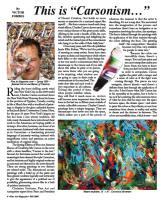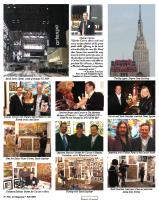 |
|
Fine Art Magazine - Fall 2009 - USA - PAGE 5
|
Fine Art Magazine - Fall 2009 - USA
Carson, page, 5,6,7
Charles Carson at The Montreal Museum of Fine Arts — Gala ACADEMIA XXI — where he was honored as Artist of the Year “Charles Carson shows each and every unique feature of his great poetic skills, offering in his work a breath of life, his own life. Proof that Carson has worked his way toward artistic posterity came on the day that we started saying ‘It’s a Carson’ in the same way that we proclaim ‘It’s a Picasso, a Matisse,a Warhol,a Basquiat’or any other immortal artist.’’
—Christian Sorriano, Fine Art and Antiquities expert.
President of Drouot Cotation, Paris
This is “Carsonism…”
By VICTOR FORBES
Riding the bone-chilling north wind into New York City on his 2009 world tour, Charles
Carson motored down the New York State Thruway from his home in the province of Quebec, Canada, roaring in like a March lion with a truckload of paintings to display in the glass cathedral known as the Jacob Javits Convention Center. Here, for the past 20 years New York’s largest art fair has been a late winter tradition. All told, many thousands have introduced their work to the American art buying public at Artexpo. Few alive, however, can boast of an art movement christened with their surname, as in Carsonism—a fascinating pictorial language of painterly writing imbued with magnificent colors and patterns; an active meditation of original ideas.
The Spring Edition of Fine Art, featured Heroes of Creativity, Mr. Carson on the cover with a clever headline, “Carson to the ism.” Several Art historians around the world and museologist have deemed his style Carsonism,and his intricate and highly original works are as punctual and directed as the artist himself. These are strong paintings in two distinct yet related styles. The dimensional mosaic paintings with a build up of the paint and then glazed combine logically and intricately to give the appearance of a polished sea of possibility, glimmering mirror-like in a bath of pristine luminosity.
|

|
|
Charles Carson at Art Expo, New York 2009
|
Christian Sorriano, Fine Art and Antiquities expert from Paris and President of Drouot Cotation, “Art holds no more secrets or mysteries for a matured expert like myself. … Far from common trends and cheap visual effects, Charles Carson shows each and every unique feature of his great poetic skills, offering in his work a breath of life, his own life, therefore questioning and delighting the minds and the trained eyes of the connoisseurs who hang it on the walls of their daily lives.”
Over many years, said Fine Art publisher Jamie Ellin Forbes, “We’ve had the privilege of meeting so many artists. Some have risen to great acclaim and importance while others have fallen to the wayside. Each brings his or her own need to communicate their own dreamscape to the viewer and if you talk about this either in print or in person, you never know who you are going to be inspiring, what window you are going to open in their souls to communicate to the next level. The artist does this and such work is very important in all cultures. During this period of time, when people redefine values, they will find it much more so. Artists will become more important than they have been in the last ten or fifteen years outside of certain collectible concerns. Charles Carson’s paintings have a unique language. They are dreamscapes that invite you into the space, which makes you a part of the process of whatever the moment is that the artist is describing. It’s not a snap shot. You are invited into the imagination of the process and somewhere there’s been an instigation or an inspiration involving the colors, the mystique. The line is defined through the paintings with the application of the form married through the colors defining the lines. The painting itself—the composition—therefore becomes very free, very available for people to enter into.”
|
 |
|
Fine Art Magazine - Fall 2009 - USA - PAGE 7
|
“Because the colors are incredibly clean, there’s a tempo. You can’t just paint and you can’t extra-polate unless you know form; you have to know form, you have to be able to paint in order to extrapolate. Carson applies the paint with a tempo and a sense of color as if the light were coming through. The pieces are very energetic, almost kinetic—and there’s a definite form lent through the application of the color. I don’t know what Mr. Carson has in his mentality as he paints, but it looks to me as if he’s painting the subconscious vision of what he sees; that he steps into the space between space, the dream space—and starts to paint the colors as they vibrate, as one form transitions from dream to reality and reality to dream and the abstract in-between. The colors are incredibly clean, which is rare—and they are built, have definition and are textural. You would think that it’s simple, but it is not. This is a very complex and difficult mode of expression to arrive at and you have to have an understanding of harmony and tempo to have a significant balance throughout the piece in order to create the composition. The result is the school of thought Carson is forming—Carsonism, Carson to the ism.” There are elements to this work that I have not seen elsewhere. I have not seen this technique done elsewhere. Have you?
“Isn’t this the founding of a thought process or a school? Did anybody do Braque or Leger, or Pollock before they did themselves?”
|
|
|